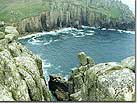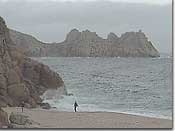|
|
|
West Penwith (the Land's End peninsula) is the southernmost
area of England, and the most picturesque part of Cornwall.
It is rich in dramatic beaches, wooded valleys, moorland,
rolling farm land, and hidden coves; much of it is designated
as Areas of Outstanding
Natural Beauty.
|
|
|
The far South West is warmed by south westerly breezes from
the Azores, and is one of the most unpolluted areas in Britain.
It has a special, indefinable quality recognized by locals
and visitors alike. Its 144 square miles still supports an
active small scale farming and fishing community, with a unique
beauty that draws visitors back year after year.
|
 |
 |
The coastline is full of beaches, ranging from safe
bathing beaches and secluded coves, to wild and rocky places.
Some are easily accessible and some less so. Although there
are several traditional seaside resorts for family visitors,
the area also attracts walkers, naturalists, artists, and
anyone seeking a quiet haven, with amenities close by. The
sea is crystal clear, jade green, and a comfortable swimming
temperature into late autumn.
|
|
The Land's End peninsula is in the path of the warm Gulf
Stream, and cold weather is rare. Frost and snow are rare,
and the climate is ideal for semi-tropical plants, many of
which can be seen in local gardens and public parks as well
as in public show gardens, like Trengwainton, Trewidden, and
Tresco Abbey Gardens on the nearby Scillies.
|
|
West Penwith also has more ancient sites than any other area
of Britain, ranging from stone age to iron age monuments and
settlements. These include four stone circles, 90 standing
stones, and numerous hill forts, village settlements, quoits,
and burial barrows..
|
|
|
"I gradually discovered the remarkable
pagan landscape which lies between St. Ives, Penzance and
Land's End; a landscape which still has a very deep effect
on me, developing all my ideas about the relationship of the
human figure in the landscape - sculpture in the landscape
and the essential quality of light in relationship to sculpture,
which induced a new way of piercing the forms to contain colour."
Barbara Hepworth, 1952
|
TOP
|

